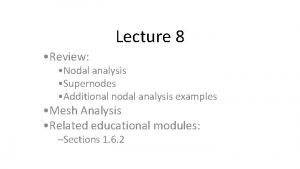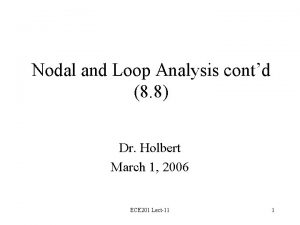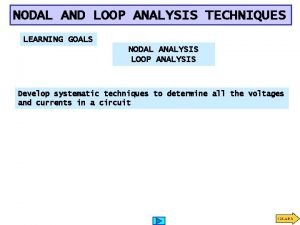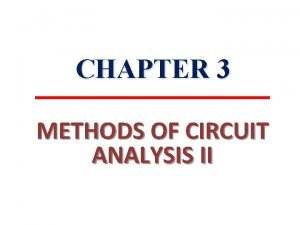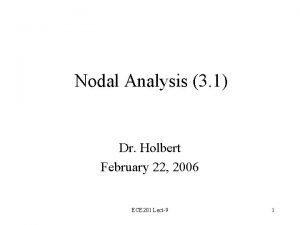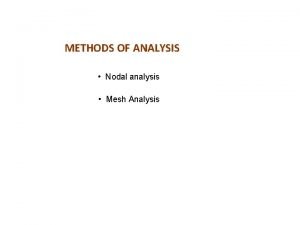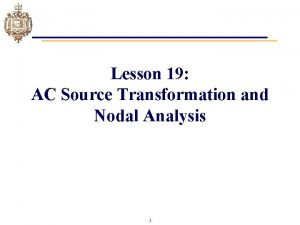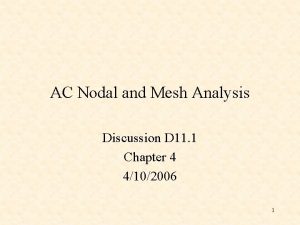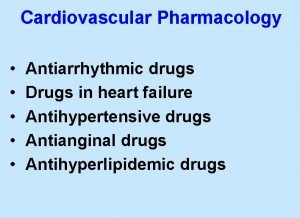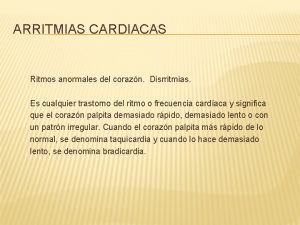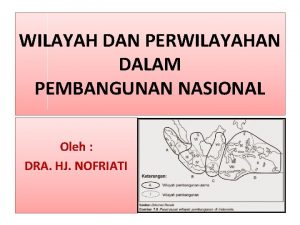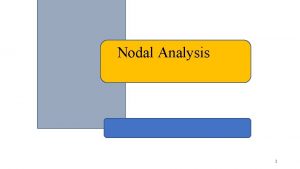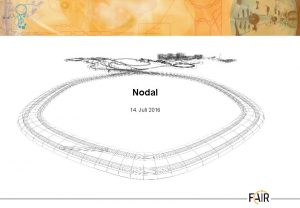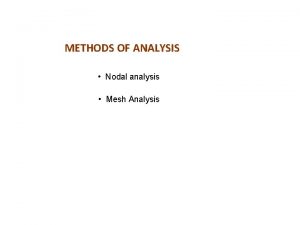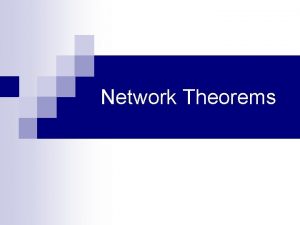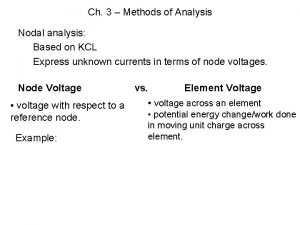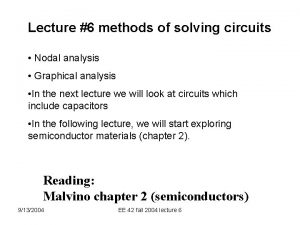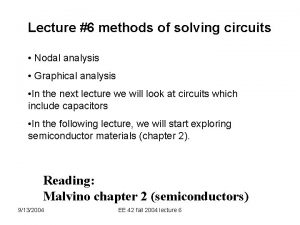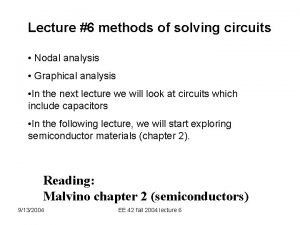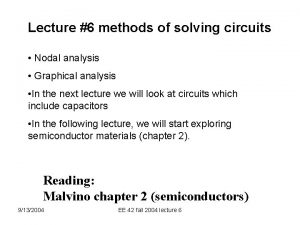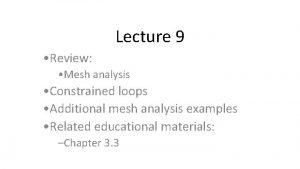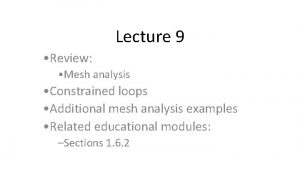Lecture 8 Review Nodal analysis Supernodes Additional nodal



















- Slides: 19

Lecture 8 • Review: • Nodal analysis • Supernodes • Additional nodal analysis examples • Mesh Analysis • Related educational modules: –Sections 1. 6. 2

Review: Nodal Analysis 1. 2. 3. 4. 5. 6. 7. Choose reference node Identify independent nodes Label “constrained” voltages Apply KCL at independent nodes Write the KCL equations in terms of node voltages Solve equations to determine the node voltages Determine desired circuit parameters from node voltages

Supernodes • In example 3 of lecture 7, we applied KCL at a supernode

Supernodes – continued • A node is defined as having a single, unique voltage • We can, however, apply KCL at supernodes which contain multiple nodes • Example:

Supernodes in nodal analysis • Supernodes are especially useful in nodal analysis when dependent nodes (voltage sources) are present • Define a supernode containing the dependent nodes • The supernode contains the voltage source and the nodes to which it is connected • Apply KCL at the supernode

Supernodes are useful, but not required • Supernodes are not essential for nodal analysis, as long as you account for all currents • Need to explicitly include currents through voltage sources • Lecture 7, Example 3:

Lecture 7, Example 3 – alternate approach

Example 1 • Determine the voltage across the 6 resistor

Example 1 – alternate approach

Example 2 • Use nodal analysis to write a set of equations from which you can determine the current through the 6 resistor.

Mesh analysis – review • Identify mesh loops • The currents around these loops are the mesh currents • Use Ohm’s Law to write KVL around each loop in terms of the mesh currents • Solve these equations to determine the mesh currents • Any desired circuit parameter can be determined from the mesh currents

Nodal and mesh analysis – comparison • Nodal analysis: • Mesh analysis: • Define independent nodes • Define “mesh loops” • Apply KCL at independent nodes • Apply KVL around the mesh loops • Use Ohm’s Law to write KCL in terms of node voltages • Use Ohm’s Law to write KVL in terms of mesh currents

Mesh Analysis • We will illustrate the mesh analysis technique in the context of an example circuit:

Mesh Analysis • Step 1: Choose mesh loops and identify mesh currents • Kill sources (short voltage sources, opencircuit current sources) • Recommendation: mesh loops should not have other loops in their interior •

Mesh Analysis • Step 2: Replace sources and write constrained loops • Constrained loops go through current sources • Constrained loops are somewhat arbitrary, but their direction and magnitude must be consistent with the source through which they pass

Mesh Analysis • Step 3: Apply KVL around the mesh loops • Use Ohm’s Law to write voltage drops in terms of mesh currents • Voltage polarities in KVL must be consistent with that loop’s mesh current

Mesh Analysis • Step 3: continued –

Mesh Analysis • Step 4: Solve the equations for mesh currents • Use mesh currents to determine the circuit parameters of interest • Note: The total current in an element is the sum of the mesh currents in the element •

 Nodal analysis supernode
Nodal analysis supernode Advantages of nodal analysis
Advantages of nodal analysis Site:slidetodoc.com
Site:slidetodoc.com Nodal analysis steps
Nodal analysis steps Nodal analysis
Nodal analysis Nodal analysis
Nodal analysis Nodal analysis
Nodal analysis Process transformation
Process transformation Nodal analysis
Nodal analysis Find v
Find v Ac nodal analysis
Ac nodal analysis 01:640:244 lecture notes - lecture 15: plat, idah, farad
01:640:244 lecture notes - lecture 15: plat, idah, farad Tissu nodal localisation
Tissu nodal localisation Myoplasme et sarcoplasme
Myoplasme et sarcoplasme Cellule myoendocrine
Cellule myoendocrine Michele casula
Michele casula Lineas antinodales
Lineas antinodales Mechanism of action of quinidine
Mechanism of action of quinidine Arritmia sinusal con cvp
Arritmia sinusal con cvp Wilayah dan perwilayahan dalam pembangunan nasional
Wilayah dan perwilayahan dalam pembangunan nasional
